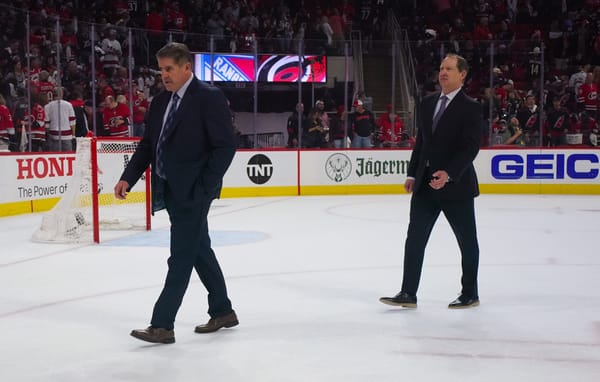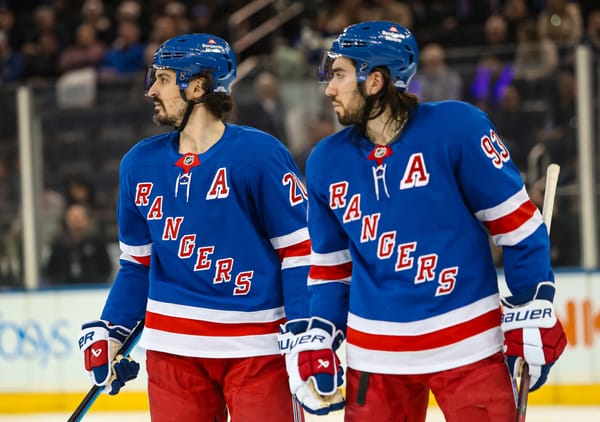Rangers Analysis: Giving Rangers Prospects an NHL Points Equivalent
First, big s/t to RangerSmurf, who has been helping me understand a myraid of new metrics in evaluating not only NHL players, but prospects as well.
The guys at Behind the Net, who are pretty much the metrics kings of hockey, have deduced a formula to help understand what the NHL scoring equivalents of the minors would be. It is a very interesting concept, as it is very difficult to understand how point totals in the AHL, Canadian Juniors, NCAA, and other international leagues translates to NHL success. The Rangers have a lot of top quality prospects in the pipeline, some are highly touted and young, others are not as publicized, but more NHL ready.
With some Rangers prospects putting up big numbers, and other prospects turning pro, Rangers fans can't help but get excited at the potential. While most expect there to be a learning curve, what can you really expect from someone like Derek Stepan, who recently signed with the Rangers? What can you expect from someone like Bobby Sanguinetti, or Evgeny Grachev, if they were to play with the Rangers next season? Luckily, we can get a realistic expectation for each prospect using these metrics. So let's take a look at some of the top Rangers prospects and what can realistically be expected from them if they were to play in the NHL next season:
To explain the math, the total number of games played is divided into 82 (for a full NHL season), and that number is then multiplied by the player's point total to get an 82 game equivalent. This number is then multiplied by the NHL equivalent multiplier to get an estimated NHL equivalent (NHLe).
| Player | League | Points | Games | NHLe |
| Derek Stepan | NCAA | 54 | 41 | 44 |
| Carl Hagelin | NCAA | 50 | 45 | 37 |
| Chris Kreider | NCAA | 23 | 38 | 20 |
| Ryan McDonagh | NCAA | 18 | 43 | 14 |
| Ryan Bourque | Juniors | 43 | 44 | 23 |
| Chris Doyle | Juniors | 69 | 63 | 26 |
| Roman Horak | Juniors | 47 | 66 | 17 |
| Sam Klassen | Juniors | 30 | 67 | 11 |
| Tomas Kundratek | Juniors | 35 | 65 | 13 |
| Ethan Werek | Juniors | 64 | 57 | 27 |
| Mats Zuccarello-Aasen | Swedish | 55 | 64 | 55 |
| Pavel Valentenko | Russian | 7 | 0 | N/A |
| Roman Psurny | Czech | 40 | 37 | 66 |
| Evgeny Grachev | AHL | 28 | 80 | 13 |
| Bobby Sanguinetti | AHL | 38 | 61 | 22 |
| Dale Weise | AHL | 50 | 73 | 25 |
| Dane Byers | AHL | 52 | 64 | 29 |
| Corey Potter | AHL | 28 | 69 | 15 |
The interesting thing here is that the players you think would be at the top are simply not there. This is because the metric measures what to expect at the current moment, and not what to expect a few years down the road. This is why someone like Roman Psurny, who plays in the Czech league and puts up fairly decent numbers, is at the top of the list here. Clearly, players like Stepan, Kreider, and Werek have higher ceilings, but they are not NHL ready, whereas, based on this metric, Psurny would have relatively little difficulty adjusting to the NHL. Additionally, the metric makes some career AHL players, like Corey Locke, appear better than they really are.
Now, this is clearly not the be-all-end-all of each prospect. There are many other factors which play a big role in how each prospect will adjust, such as style of play, raw ability, and potential. Someone like McDonagh or Valentenko, who do not play offensive styles, will be look worse than what they are. This does not take into account age of NCAA players either, as Kreider will surely increase on his numbers as he progresses. In fact, the only league that has age taken into account is Canadian Juniors, due to the generally young players and raw aspect of each talent. Interestingly enough, the age factor actually decreases the multiplier here, thus lowering point expectations. But, point totals are only a part of what a player brings to the table. Playermakers like Stepan are often dependent on quality of linemates, which this metric does not account for. However, in terms of raw stats, this is a fairly good estimate of what to expect from certain players, if they are to turn pro.
Essentially, you can take this article for what it is; a raw, numbers based analysis that simply does not take into account how each player plays, what each player's potential is, or many other factors that make hockey players, well, hockey players. Each stat listed about should be taken with a grain of salt. Expecting Stepan to reach 40 points isn't exactly unreasonable, but expecting someone like Psurny, who has been off of many people's radars for good reason, to produce 60 points is extremely far fetched. In the end, I recommend reading up on what Laurie Carr (Beyond the Blueshirts), Jess Rubenstein (Prospect Park), and Leslie Treff (HockeysFuture) have to say, as they are the ones to talk to in regards to prospects.




